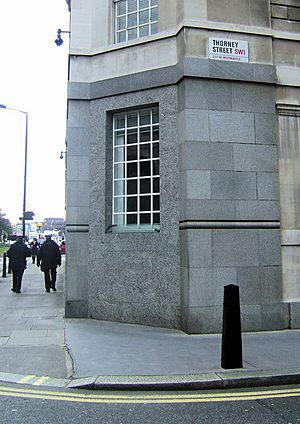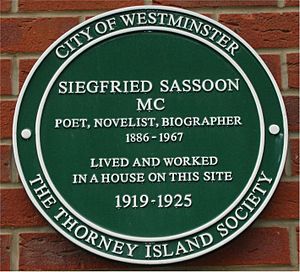Thorney Island (Westminster) facts for kids
Thorney Island was once a small island in the River Thames in London. It was located upstream from the old city of London. This island was formed by tiny streams flowing from the River Tyburn, which joined the Thames nearby.
Today, two very famous buildings stand where Thorney Island used to be: Westminster Abbey and the Palace of Westminster. The Palace of Westminster is also known as the Houses of Parliament.
In ancient Roman times, and probably even before that, Thorney Island might have been part of a natural crossing point over the Thames. This was important before the first London Bridge was built.
Contents
What's in a Name?
The name "Thorney" comes from an old English word, Þorn-īeg. This means "Thorn Island". It suggests the island might have been covered in thorny bushes or trees a long time ago.
A Changing Island
Early History
Records from the 700s describe Thorney Island as a "terrible place." It was probably wild and difficult to live on.
However, things began to change. In the year 893, Edward the Elder, who was the son of Alfred the Great, made invading Vikings take shelter on Thorney Island.
Over the next few centuries, monks worked hard to make the island a better place. By the time Edward the Confessor was king, it was described as "A delightful place, surrounded by fertile land and green fields."
The Oldest Garden
A special part of Westminster Abbey, called the College Garden, is still there today. It is over a thousand years old and is thought to be the oldest garden in England. Imagine a garden that has been growing for so long!
Thorney Island Today
Since the Middle Ages, the land level has risen. The small streams that formed the island have been covered up. Also, the Thames Embankment was built, which changed the river's edge. Because of these changes, you can no longer see Thorney Island as a separate piece of land.
The name "Thorney" is mostly remembered by a street called Thorney Street. This street is located behind the MI5 Security Service building. There is also a local group called The Thorney Island Society, which was started in 1976 to celebrate the area's history.
King Canute and the Tides
Thorney Island is one of the places where the famous story of King Canute and the waves is said to have happened. In this story, King Canute showed his followers that even a king cannot command the tides of the sea. He built a palace at Westminster, which was on Thorney Island, and this is where the demonstration supposedly took place.
A Modern Connection
In the year 2000, a politician named John Roper was given a special title in Parliament. He chose to use the name Thorney, becoming Baron Roper of Thorney Island. This helped keep the old name of the island alive in a new way.
See also
 In Spanish: Thorney Island (Londres) para niños
In Spanish: Thorney Island (Londres) para niños



